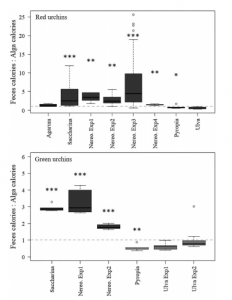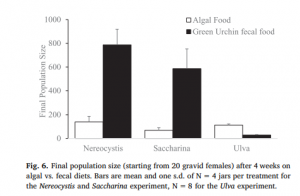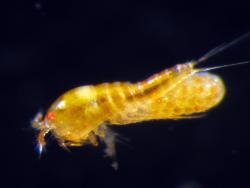Feces…as Food!?
As most elementary students can tell you, primary productivity is driven by the sun, not just in most oceanic environments, but in terrestrial and human dominated systems as well. In aquatic systems, the photosynthetic boom at the surface subsidizes systems in deeper, darker waters. Phytoplankton enters this deep-water food web as detritus, small or large organic particles often resulting from messy feeding, drifting decomposition, or fecal material. In the pacific northwest, large kelp plants ripped from their strongholds often join the mix, drifting down to depths where urchins quickly devour the algae. Fecal material, or “compact aggregations of organic matter”[1] is particularly interesting, as some consumers, including the local urchins, Mesocentrotus franciscanus (red) and Strongylocentrotus droebachiensis (green), are often inefficient digestors. In fact, a large proportion of urchin feces consists of unprocessed algal material in a lovely mucus broth, prime for microbial colonization as they ‘age’. This microbial addition may be a critical supplement to benthic communities, both for the additional caloric load, but also because the microbes can fix dissolved inorganic material.[2]
Urchins vs. Kelp
A group of scientists from across the country led by Megan Dethier at the University of Washington, Friday Harbor, ran a series of experiments to investigate just how important these sea urchin feces can be to benthic ecosystems. The two urchin species were tested on exclusive diets of several different alga, including four kelp species (Nereocystis spp., Saccharina latissimi, and Agarum fimbriatum) a red alga (Pyropia), and a green alga (Ulva). Nutrition in and out were carefully monitored and measured in a series of experimental treatments and controls. In the last set of experiments, a harpaticoid copepod, Trigriopus californicus, was used to compare the growth potential of the different diets: fresh algae or algal feces.

The above graph shows the ratio of caloric content of feces produced by urchins fed a particular kelp species, as compared to the original kelp tissue. Together, the experiments indicate that urchin feces are not substantially less nutritious than fresh algal tissue, and by some measures are even more nutritious! Feces produced by both urchin species after consuming the two experimental kelp species had more calories and carbohydrates than the fresh kelp tissue (though the pattern didn’t hold for the other types of algae tested). Proteins were higher in feces across the board, for all urchin species and all algae tested, including the Ulva and Pyropia. Some trials indicate that the benefits may increase as feces age, though most comparisons were not significant. The grazing copepod experiments provide yet another reason to keep pursuing the thesis: the groups that consumed kelp-derived fecal food had significantly larger final populations compared to the groups eating fresh kelp tissue.
This is a common situation in scientific research, particularly in biological and ecological studies on living organisms. Some trials are statistically significant, while other trials don’t meet the standard. Significance, statistically speaking, is a way of singling out only results that were exceedingly unlikely to have occurred by chance alone. Depending on sample size and effect size, multiple trials testing the same thing can have different results, statistically speaking. In this case, some trials indicate increasing nutrition with fecal age that cannot be attributed to chance, while others could have resulted by chance alone. The authors (or their graduate students) are likely pursuing additional trials as I write this!
OK, Feces as Food. But Feces… as baby food!?

Figure 6 from this study shows the results of the Tigriopus population study. Groups of 20 gravid (egg bearing) females fed urchin feces produced larger populations than those fed algae. As a small, benthic feeder, this organism would frequently come across urchin fecal pellets and would have a much easier time digesting the small pellets than the much larger kelp blades. The authors note that the fecal pellets contain sufficient nutrients to support Tigriopus’ entire life cycle!
All these changes in fecal quality are likely due to the urchins’ gut bacteria. Gut bacteria are the naturally present (good) microbes in an organism’s digestive system – an urchin’s, a cow’s, and a human’s. Your gut microbiota is a hot topic in medicine and wellness, how can it be manipulated to increase or reduce weight loss, how it can be used for diagnosing and potentially curing a host of diseases, how it can be inadvertently changed by diet and circumstance, and how those changes can be repaired. (Go ahead – google ‘C. diff fecal transplant’ – I dare you.) When it comes to urchins, studies by Hakin et. al. (2015 and 2016) found that echinoid gut bacteria previously identified as “capable of digesting algae” are important to carbohydrate, amino acid and lipid metabolism; and that these bacteria are distinct from those in the mucus of fecal pellets. This implies that residence time in the gut (the time that food spends within an organism’s digestive system) likely has a large influence on the nutrition of the feces. When considered alongside the authors’ observation that larger urchins both consumed more kelp and egested more material than smaller urchins, the residence time factor because doubly interesting, and deserving of more attention.

These data are convincing on their own, but when you consider just how much algae-derived nutrition urchins can provide to the benthos, the implications are staggering. Urchins, covered in many an Oceanbite article, are an essential link, connecting the nutrition in attached and drift algae beds to benthic communities at varying depths. Vast regiments of urchins (as high as 500 individuals per square meter) graze together in aggregations that can reach hundreds of meters in depth, each meter of which can consume up to 1 kg of kelp per day. That’s a lot of feces, and a huge food resource for benthic communities.
Lowe et. al. (2015) found higher grazer and detritivore abundance under red sea urchins, suggesting it was due to the shelter and the algae-shredding service provided by the urchins. This study supports the idea that fecal algae production is yet another way that sea urchins act as essential ecosystem engineers in shallow systems.
[1] Sauchyn and Scheibling 2009. Aquatic Bio 6, 99-108.
[2] Povero et al 2003 Polar Biol 26, 302-310.

